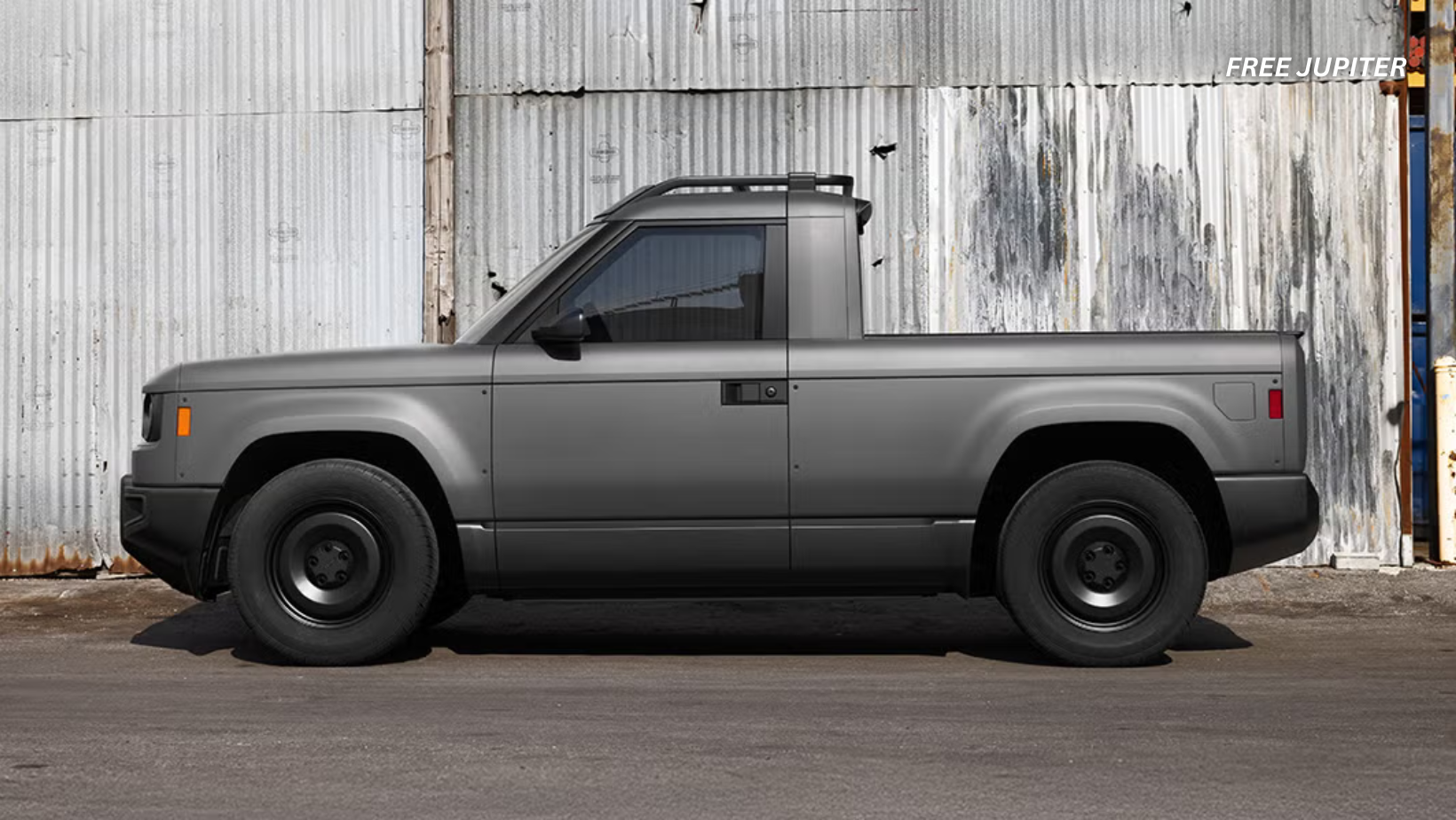Friendly Note: FreeJupiter.com shares general info for curious minds 🌟 Please fact-check all claims—and always check health matters with a professional 💙
In an age where cars talk to you, park themselves, and practically demand a software update before letting you drive, one American startup has decided to go in the complete opposite direction. Say hello to the Slate Truck, a bare-bones electric vehicle that proudly arrives without a glossy finish, touchscreen, or even a stereo. Priced at just $20,000, this minimalist EV is shaking things up—not by adding more, but by boldly offering less.
If Tesla is the iPhone of electric cars, then Slate is the Nokia brick phone of EVs—tough, affordable, and refreshingly free from digital distractions.
Back to Basics, But Electric
Set for release in 2026, the Slate Truck looks like something you’d see in a futuristic garage owned by a practical do-it-yourselfer. It’s a two-seater with simple lines, thick plastic panels (unpainted, mind you), and absolutely no touch-sensitive gadgets vying for your attention. It’s not trying to be flashy or overly smart—it’s just trying to get the job done.
And in doing so, it raises an important question: Do we really need all the extras in modern vehicles—or have we just been sold the idea that we do?
Read more; A Car Salesperson Exposes Why Test Driving Cars at the Dealership Is a Bad Idea
A Truck That Doesn’t Try Too Hard
There’s no chrome, no leather upholstery, no voice-activated assistants. Instead, the Slate Truck offers simplicity with a twist of creative freedom. Drivers can personalize the look of their vehicle with vinyl wraps, bolt-on features, and custom kits. Want your truck to look like a tiger-striped banana? Knock yourself out.
By eliminating options like paint, trim levels, and complex infotainment systems, Slate Auto is slashing production costs—and it shows in the truck’s price tag. In fact, much of the cost savings come from skipping industry-standard equipment like paint booths and assembly line reprogramming.
One model. One trim. One color. And zero unnecessary fluff.
The Digital Detox Vehicle
The Slate Truck is being dubbed the “digital detox” of electric vehicles. In a time when everything is connected—from your toothbrush to your toaster—this truck makes a bold move by choosing not to be.
The idea is simple: many drivers don’t want their cars to feel like smartphones on wheels. There’s a growing population of people who are tired of the learning curve that comes with every new model year. These are folks who don’t want their driving experience filtered through a 15-inch screen or interrupted by Bluetooth pairing issues.
Slate’s answer? Analog charm with electric heart.
Read more: You’ll Be Shocked How Many Trees Lightning Destroys Every Year
Safety Without the Sass
Just because the Slate Truck is minimal doesn’t mean it’s unsafe. In fact, the company is targeting a 5-star crash test rating, the gold standard in vehicle safety. The materials may be plastic, but this isn’t your average toy truck. It’s engineered for resilience, with plans for rugged durability and low-cost repair options.
To help users keep their trucks in shape, Slate will even launch “Slate University,” an online portal where owners can learn how to do basic maintenance and install upgrades themselves. It’s vehicle ownership made simple—and empowering.
Tech-Free Isn’t a Step Back—It Might Be the Future
Ironically, by avoiding many of the high-tech features that dominate today’s vehicles, the Slate Truck might actually be ahead of its time. A growing number of consumers are expressing “tech fatigue”—a weariness of constant notifications, software glitches, and complicated interfaces. It’s the same sentiment fueling the rise of dumb phones—minimalist mobile phones with no apps and limited connectivity, designed for digital detoxing.
Think of the Slate Truck as the automotive version of a flip phone. It’s a response to over-complication, an invitation to return to practicality, and a statement that maybe we don’t need a glowing rectangle in every corner of our lives—including the dashboard.
Minimalist Design in Other Fields: A Wider Trend
The Slate Truck isn’t the only invention challenging the “more is better” philosophy. Across industries, there’s been a wave of deliberate minimalism aimed at reducing costs, increasing accessibility, and eliminating unnecessary complexity.
- The Fairphone, for instance, is a modular smartphone built for longevity and repairability. Like Slate, it focuses on sustainability and practicality over flashy features.
- In the furniture world, IKEA’s “no-frills” flat-pack design became iconic for its simplicity, affordability, and DIY spirit—an ethos that echoes in Slate’s customizable truck kits.
- Bauhaus design principles, originally popularized in the early 20th century, are also enjoying a resurgence—celebrating form that follows function, which Slate’s truck certainly embodies.
Even in the world of computing, Raspberry Pi computers—tiny, low-cost, single-board devices—have inspired tech enthusiasts to build their own systems from scratch, skipping the bloated software that often weighs down mainstream machines.
In short, less is becoming more again, and the Slate Truck fits right into this global conversation.
The EV Market Is Ripe for Disruption
Let’s face it—many electric vehicles on the market today are expensive. Some feel more like luxury gadgets than transportation tools. Between software subscriptions, self-driving ambitions, and touchscreens that need monthly updates, owning an EV can start to feel like managing a very large tablet on wheels.
Slate Auto is cutting through all of that. Their vision is refreshingly simple: Make electric transportation affordable, easy to fix, and widely accessible. This approach not only appeals to budget-conscious drivers, but also to rural communities, fleet managers, small business owners, and others who need reliable, functional transportation without a luxury tax.
And investors are taking notice. While nothing’s been officially confirmed, rumors suggest Jeff Bezos is among those keeping an eye on Slate’s progress. If that’s true, it shows that even the titans of tech see value in going low-tech.
The Big Question: Will People Actually Buy It?
The biggest hurdle Slate faces isn’t production—it’s perception. Are drivers willing to let go of their heated leather seats and panoramic sunroofs? Will they trade ambient lighting and voice assistants for a truck that, while electric, feels analog in every other way?
Perhaps surprisingly, there are signs that the answer could be yes. As living costs rise and economic uncertainty lingers, many people are rethinking their spending habits. Cars, once symbols of luxury, are returning to their original purpose: getting from A to B safely and reliably.
For people who don’t want to take out a second mortgage just to afford a vehicle—or who are simply overwhelmed by tech—Slate’s truck might be exactly what they’ve been waiting for.
Read more: If You Turn Down the Radio to See Better, You May Be Gifted in These 8 Weird Ways
Conclusion: The Beauty of a Blank Canvas
The Slate Truck may not have the flash or glamor of a high-end EV, but that’s by design. It’s a blank canvas on wheels—a functional, affordable machine that lets owners take control of their ride, rather than being controlled by it.
In a world of bloated features and rising prices, this stripped-down electric truck is daring to ask, “What if driving didn’t have to be so complicated?”
And that, perhaps, is the most revolutionary idea of all.










